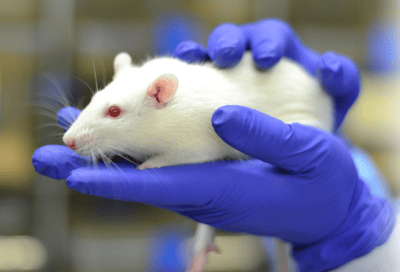Mice have long been the preferred mammal model in research labs due to their cost, size, and tractable genetics. Their behavioral simplicity, however, limits a researcher’s options for studying the component features that may serve as surrogate measures of intellectual disability (ID), autism spectrum disorder (ASD), and disrupted social behaviors, such as in Prader-Willi syndrome (PWS) and Schaaf-Yang syndrome (SYS). Both of these syndromes may arise due to changes in the MAGEL2 gene, with SYS caused by mutations in the gene that result in a shortened (truncated) version of the MAGEL2 protein, and PWS typically involving complete loss of the gene and therefore no MAGEL2 protein produced at all.

Rats display more complex behaviors including sociability not found in mice, enabling more sophisticated assessment. Moreover, the increased size of rat organs simplifies anatomical assessments like ultrasound. For these reasons, Rodney Samaco from Baylor College of Medicine and colleagues recently undertook to generate a new rat model with a disruption in its Magel2 gene similar to that found in SYS, and the initial characterization of its physiology and behavior were reported in the journal Disease Models and Mechanisms. Derek Reznik, the graduate student who led the research, provides his insight into the findings in an interview with the journal.
Notably, this is also the first animal model of a truncated MAGEL2 – mouse models typically used in PWS research lack the entire gene. This is a significant advancement for SYS research, as the molecular mechanisms underlying the increased prevalence of ID, ASD, and disrupted social behaviors in SYS compared to PWS are not well understood. Simply put, why is a truncated MAGEL2 worse than no MAGEL2 at all? As expected at the cutting edge of science, extraordinary steps (high-performance liquid chromatography mass spectrometry) were required to demonstrate that the truncated MAGEL2 was indeed present in the hypothalamus of these animals as expected (i.e. the cells’ natural quality control systems had not eliminated the altered MAGEL2 protein). This is a key finding in support of the hypothesis that truncated MAGEL2 may have detrimental activity that leads to the features seen in SYS.
Several aspects of this new rat model reflect the features reported in people with SYS , including changes in body composition as well as the cardiac and respiratory systems. In terms of body composition, rats with the Magel2 mutation had lower total body weights resulting entirely from reduced muscle mass and no change in fat mass, i.e. an overall increase in body fat percentage. They also exhibited decreased bone area, bone mineral content, and bone density, similar to what is seen with humans who have SYS or PWS. In the cardiac system, these rats were affected in both diameter and mass of the left ventricle of the heart (leading to reduced blood output, which the rats compensated for by elevating heart rate); and altered electrical activity. Finally, the researchers determined the rats showed breathing irregularities that included increased expiratory time, reduced peak expiratory flow, and decreased apnea counts and duration.
Perhaps the most significant advantage of rats over mice is their more evolutionarily developed behavioral catalog, with well-established tests for anxiety-like behavior, sociability, locomotor function, sensorimotor gating, perseverative behavior, learning and memory, and pain perception. As with humans, the truncating MAGEL2 mutation led to alterations in anxiety-like and social behaviors, however the SYS rats surprisingly exhibited less anxiety than typical rats in two common tests, the elevated circle maze and the marble burying test. In the elevated circle maze rats are given a choice between occupying closed and open spaces – rodents typically prefer closed spaces, but SYS rats spent more time in open regions and less time in closed regions compared to wild-type littermates. Similarly, while rodents typically bury unfamiliar objects (e.g. marbles) introduced into their environment, the SYS rats buried fewer marbles than wild-type littermates. One possible explanation is that these rats were so much more frightened by the marbles that they were afraid to even touch them for burying, but it is clear that more sophisticated tests may be needed to truly define the role of MAGEL2 in anxiety. Nevertheless, these studies do reveal that MAGEL2 activity is directly linked to behavior and neuropsychiatry. Notably, the new rat model also showed aberrant social behavior. Rats simultaneously presented with an unfamiliar rat and an unfamiliar inanimate object (e.g. a cup) typically spend more time investigating the other rat. The new SYS rats, however, spent comparable amounts of time with each. Furthermore, in social settings young rats typically engage in ‘rough and tumble’ play (e.g. pouncing, wrestling, pinning), but the Magel2 mutated rats spent significantly less time in play-like behavior.
The studies described only scratch the surface of the potential for this new animal model to help us learn more about SYS and PWS. Additional studies to further explore the physiology and behavior of these animals are ongoing. Relevant to the roles of MAGEL2 in both PWS and SYS, FPWR is supporting analysis of serum for hormone and neuropeptide deficiencies (e.g. IGF-1, ghrelin, growth hormone, BDNF) and morphological analysis of the hypothalamus at a subcellular scale to determine the mutation’s effects on how vesicles are generated and move through the cell, as MAGLE2 seems to have an important role in this process. Further, these rats are expected to play a rapidly increasing role in the testing of therapies under development for PWS and SYS, as all the advantages noted will enable much more precise definition of therapeutic mechanisms and benefits as compared to current mouse models. The availability of this new rat model will provide researchers with new opportunities to understand SYS and PWS and develop new therapies to treat both disorders.








